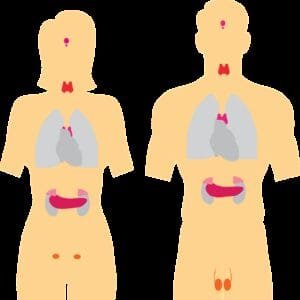Understanding Fluoride’s Impact on Pineal Gland Function

Wellness Fixation is reader supported, meaning I may earn a small commission if you purchase something through my links at no extra cost to you. Thanks for your support! Learn more
Key Takeaways
- The pineal gland is a small, yet crucial, part of the brain responsible for producing melatonin, which regulates sleep-wake cycles.
- Fluoride, commonly found in water and dental products, can accumulate in the pineal gland more than in other soft tissues.
- High levels of fluoride in the pineal gland have been associated with increased calcification, potentially affecting its function.
- Calcification of the pineal gland can lead to decreased melatonin production and disruption of circadian rhythms.
- Natural health enthusiasts can reduce fluoride exposure by using water filters and choosing fluoride-free dental products.
Understanding Fluoride’s Impact on Pineal Gland Function
When we talk about the pineal gland, we’re diving into a world of intricate bodily functions. Nestled deep within the brain, this tiny gland holds the key to some significant processes, especially when it comes to our sleep patterns and circadian rhythms. But, what happens when an external factor like fluoride enters the equation? Let’s unravel this mystery together.
Brief Overview of Pineal Gland
The pineal gland, although small and shaped like a pine cone, plays a mighty role in the human body. It’s often dubbed the “third eye” due to its central location and its role in regulating various hormonal functions. Most importantly, it produces melatonin, a hormone that orchestrates our sleep-wake cycles. Besides that, the pineal gland is involved in reproductive hormone regulation, impacting puberty onset and seasonal biological rhythms.
Understanding the pineal gland’s function is crucial because it provides insight into how our bodies respond to changes in the environment, including exposure to substances like fluoride.
Role of Fluoride in the Body
Fluoride is a naturally occurring mineral found in water, soil, and various foods. It’s well-known for its role in dental health, often added to toothpaste and public water supplies to prevent cavities. However, fluoride’s journey doesn’t end at our teeth. Once ingested, it travels through the bloodstream and can accumulate in various body tissues, including bones and the pineal gland.
While fluoride is beneficial in small doses for dental health, excessive exposure can lead to health concerns, sparking debates about its safety and impact on other bodily functions, such as pineal gland calcification.
Introduction to the Pineal Gland’s Functions
Let’s take a closer look at the pineal gland’s responsibilities. This gland is integral in maintaining our body’s internal clock. By releasing melatonin in response to darkness, it helps regulate sleep patterns, ensuring we get the rest we need to function optimally. Disruptions in melatonin production can lead to sleep disorders and other health issues.
Besides its role in sleep, the pineal gland also influences reproductive health. It’s involved in the timing of puberty and can affect seasonal breeding in animals, showcasing its evolutionary importance.
Accumulation of Fluoride in the Pineal Gland
Now that we understand the pineal gland’s functions, let’s explore how fluoride comes into play. The pineal gland is unique because it can accumulate more fluoride than any other soft tissue in the body. This is partly due to its high blood flow and calcification tendencies.
Research Findings on Fluoride Levels
Research has shown that fluoride levels in the pineal gland can be significantly higher than in other parts of the body. In fact, studies have found that fluoride concentration in the pineal gland can exceed that in bones, where fluoride is typically stored. This accumulation is concerning because it can potentially interfere with the gland’s functions.
Factors Influencing Fluoride Accumulation
Several factors can influence how much fluoride accumulates in the pineal gland. Age is one such factor; as we age, the gland naturally calcifies, potentially increasing fluoride storage. Dietary habits also play a role. Consuming foods and beverages high in fluoride, such as tea and processed foods, can contribute to higher fluoride levels. For those interested in addressing this, exploring methods for pineal gland detox might be beneficial.
Environmental exposure, such as living in areas with fluoridated water, can also impact fluoride accumulation. Understanding these factors is essential for anyone looking to manage their fluoride intake effectively.
Pineal Gland Calcification
Calcification of the pineal gland is a natural process that occurs as we age. However, excessive calcification can impede the gland’s ability to function properly. This process involves the buildup of calcium and, potentially, fluoride, leading to a hardened gland that struggles to produce adequate melatonin. To learn more about the symptoms and effects, visit our article on pineal gland calcification symptoms.
Process and Effects of Calcification
Calcification is a process where calcium deposits build up in body tissues, causing them to harden. When it comes to the pineal gland, calcification is a common occurrence as we age. This hardening can affect the gland’s ability to produce melatonin, leading to potential disruptions in sleep and other bodily functions. To learn more about how to maintain a healthy pineal gland, you might consider exploring pineal gland detox methods.
Most importantly, calcification isn’t inherently harmful. However, excessive calcification, especially when influenced by external factors like fluoride, can become problematic. It can limit the gland’s effectiveness, impacting overall health and well-being. Therefore, understanding and managing calcification is crucial for maintaining optimal pineal gland function.
Correlation Between Fluoride and Calcification
The link between fluoride and calcification of the pineal gland has been a topic of interest among researchers. Some studies suggest that high levels of fluoride in the pineal gland may accelerate calcification. This is because fluoride can bind with calcium, potentially increasing the rate and extent of calcification.
However, correlation does not always imply causation. While there’s evidence pointing to a relationship between fluoride and calcification, further research is needed to fully understand this dynamic. In the meantime, being aware of fluoride exposure and its potential effects on the pineal gland can help individuals make informed decisions about their health.
Potential Effects on Melatonin Production
Melatonin is a hormone that plays a pivotal role in regulating sleep-wake cycles. It’s produced by the pineal gland in response to darkness, helping signal the body that it’s time to sleep. But what happens when the pineal gland’s ability to produce melatonin is compromised? Let’s delve into the potential effects.
Impact of Reduced Melatonin
When melatonin production decreases, the body’s internal clock can become misaligned. This can lead to a host of sleep-related issues, including insomnia, disrupted sleep patterns, and difficulty falling or staying asleep. Reduced melatonin can also affect mood, leading to symptoms of anxiety and depression.
Besides sleep, melatonin influences other bodily functions, such as immune response and antioxidant activity. Therefore, maintaining adequate melatonin levels is crucial for overall health and well-being.
Disruption of Circadian Rhythms
Circadian rhythms are the body’s natural 24-hour cycles that regulate sleep, wakefulness, and other physiological processes. Disruptions in these rhythms can have widespread effects, impacting everything from sleep quality to metabolic health.
Fluoride-induced calcification of the pineal gland can lead to decreased melatonin production, thereby disturbing circadian rhythms. This disruption can result in sleep disorders, decreased alertness during the day, and even increased risk of chronic health conditions over time.
Health Implications of Altered Pineal Function
When the pineal gland’s function is altered, it can have far-reaching health implications. From sleep disturbances to potential links with neurodegenerative diseases, understanding these effects is essential for natural health enthusiasts.
Consequences on Sleep Patterns
One of the most immediate consequences of altered pineal function is the impact on sleep patterns. As the production of melatonin decreases, individuals may experience insomnia or irregular sleep cycles. This lack of restful sleep can lead to daytime fatigue, decreased cognitive function, and impaired memory.
Moreover, chronic sleep deprivation can have long-term health effects, increasing the risk of conditions such as obesity, diabetes, and cardiovascular diseases. Therefore, ensuring the pineal gland remains healthy is vital for maintaining good sleep hygiene and overall health.
Association with Neurodegenerative Diseases
Emerging research suggests a potential link between pineal gland dysfunction and neurodegenerative diseases like Alzheimer’s and Parkinson’s. While more studies are needed to establish a direct connection, the role of melatonin as a neuroprotective agent highlights the importance of maintaining healthy pineal function.
By understanding and addressing factors that may impair the pineal gland, such as fluoride exposure, individuals can take proactive steps to protect their neurological health.
Mitigating Fluoride Exposure
For those concerned about fluoride’s impact on the pineal gland, there are practical steps you can take to reduce exposure. These strategies can help safeguard your pineal gland and promote overall health.
First, consider using a water filtration system that removes fluoride from drinking water. Many filters are specifically designed to target fluoride, providing a simple yet effective solution. Second, opt for fluoride-free dental products, such as toothpaste and mouthwash. These products are widely available and can help minimize fluoride intake. For more information on the potential effects of fluoride, you can explore pineal gland calcification symptoms.
Lastly, be mindful of dietary sources of fluoride. Limiting the consumption of processed foods and beverages that may contain high levels of fluoride can further reduce exposure. By taking these steps, you can actively support your pineal gland’s health and function. For more information, consider exploring pineal gland detox methods.
Dietary Considerations
To reduce fluoride exposure through diet, it’s essential to be aware of foods and beverages that may contain high levels of fluoride. Tea, for example, is known for its fluoride content, especially black and green teas. While tea has numerous health benefits, moderation is key to managing fluoride intake.
Processed foods and beverages, including certain sodas and bottled waters, may also contain fluoride. Opting for whole, unprocessed foods can help minimize exposure. Additionally, cooking with filtered water can reduce fluoride content in meals, providing an extra layer of protection for your pineal gland.
Water Filtration Methods
Investing in a water filtration system is one of the most effective ways to reduce fluoride exposure. Reverse osmosis systems are highly effective at removing fluoride from drinking water, providing peace of mind for those concerned about its impact on health. Activated alumina filters are another option, specifically designed to target fluoride.
While these systems can be an investment, the long-term health benefits make them worthwhile. Ensuring access to clean, fluoride-free water is a proactive step towards maintaining optimal pineal gland function and overall health.
Key Takeaways for Natural Health Enthusiasts
Understanding the relationship between fluoride and the pineal gland empowers you to make informed decisions about your health. By being aware of fluoride sources and taking steps to reduce exposure, you can support your pineal gland’s function and protect your body’s natural rhythms.
“The pineal gland’s ability to regulate sleep and hormonal functions makes it a crucial component of overall health. Managing fluoride exposure is a practical step towards preserving its integrity.”
As natural health enthusiasts, it’s important to maintain a balanced approach, embracing practices that align with your health goals while staying informed about potential risks.
Maintaining a Balanced Approach to Fluoride
While fluoride has its benefits, particularly in dental health, balance is key. Understanding your personal fluoride exposure and making adjustments where necessary can help you maintain a healthy equilibrium. This might involve choosing fluoride-free products, filtering your water, or moderating dietary sources of fluoride.
Encouraging Further Research and Awareness
Ongoing research is essential to deepen our understanding of fluoride’s impact on the pineal gland and overall health. By supporting scientific studies and staying informed, you can contribute to a broader awareness of this important issue.
Engaging in community discussions and advocating for transparent information about fluoride in public water supplies can also drive positive change. Together, we can foster a culture of informed health choices and proactive wellness.
- Choose fluoride-free dental products to minimize exposure.
- Use a water filtration system to remove fluoride from drinking water.
- Be mindful of dietary sources of fluoride, such as tea and processed foods.
- Stay informed about the latest research on fluoride and health.
- Engage in community discussions to raise awareness about fluoride exposure.
Frequently Asked Questions (FAQ)
As we conclude this exploration of fluoride’s impact on the pineal gland, let’s address some common questions that may arise.
How does fluoride reach the pineal gland?
Fluoride enters the body through ingestion, primarily from drinking water, food, and dental products. Once in the bloodstream, it can accumulate in various tissues, including the pineal gland. The gland’s high blood flow and propensity for calcification make it a prime location for fluoride storage.
Understanding how fluoride travels through the body underscores the importance of managing exposure to protect the pineal gland’s function.
Is all calcification harmful to the pineal gland?
Not all calcification is harmful. The pineal gland naturally calcifies with age, which is a normal process. However, excessive calcification, potentially exacerbated by fluoride, can impede the gland’s ability to produce melatonin, leading to health issues.
Monitoring fluoride exposure and supporting the gland’s health through lifestyle choices can help mitigate the risks associated with excessive calcification.









